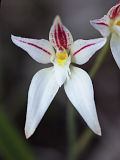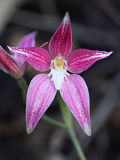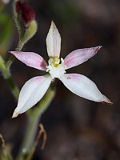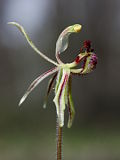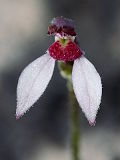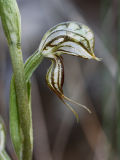Orchids of Australia
Australia is home to about 1,800 species of mostly terrestrial orchids. The south-east and south-west of the continent are particularly rich in species, with approximately 400 known orchid species occurring in south-western Australia alone. On this page I present some of the more common species of terrestrial orchids found throughout the temperate regions of Australia. Most of the featured species are endemic to Western Australia, but quite a few species (nearly 40) from the south-east of the country are included as well.
Several of Australia’s orchid species look very similar and require an expert to tell apart. This is particularly the case with Spider Orchids (Caladenia), Donkey Orchids (Diuris), Mignonette Orchids (Microtis) and Greenhood Orchids (Pterostylis). The situation is complicated further by the large number of hybrids known to exist in the wild, in particular among the Spider Orchids. Hence, a few of the species below have been marked as “unidentified”.
Lastly, most of the orchid profiles below are still incomplete and only contain photos at this stage, but no descriptions. I’m not sure if I will ever find the time to complete them.
Genera
- Acianthus
- Caladenia (Spider Orchids)
- Caleana
- Calochilus (Beard Orchids)
- Corybas (Helmet Orchids)
- Cryptostylis
- Cyanicula (China Orchids)
- Cyrtostylis
- Dendrobium
- Dipodium (Hyacinth Orchids)
- Disa
- Diuris (Donkey Orchids)
- Drakaea (Hammer Orchids)
- Elythranthera (Enamel Orchids)
- Ericksonella
- Eriochilus (Bunny Orchids)
- Gastrodia
- Glossodia
- Leporella
- Leptoceras
- Lyperanthus
- Microtis (Mignonette Orchids)
- Orthoceras (Horned Orchids)
- Paracaleana (Duck Orchids)
- Pheladenia
- Praecoxanthus
- Prasophyllum (Leek Orchids)
- Pterostylis (Greenhood Orchids)
- Pyrorchis
- Spiculaea
- Thelymitra (Sun Orchids)
Genus Acianthus
Genus Caladenia – Spider Orchids
With their large, filamentary flowers, Spider Orchids are among Australia’s most spectacular terrestrial orchids. Spider Orchids are generally common and widespread across south-eastern and south-western Australia, including Tasmania. They are particularly abundant in south-western WA where they make up more than one third of all native orchid species. There are several distinct subgenera which have been treated as separate genera by some authors.
Subgenus Caladenia – Lady Fingers
Subgenus Elevatae – Fairy Orchids
Subgenus Calonema – Spider Orchids

(Caladenia discoidea)
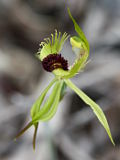
(Caladenia crebra)

(Caladenia macrostylis)

(Caladenia drummondii)

(Caladenia hirta)

(Caladenia longicauda)

(Caladenia splendens)

(Caladenia speciosa)

(Caladenia citrina)

(Caladenia swartsiorum)

(Caladenia uliginosa)
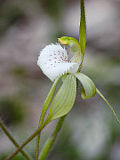
(Caladenia hopperiana)

(Caladenia excelsa)

(Caladenia nivalis)
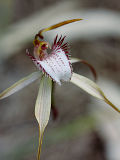
(Caladenia leucochila)

(Caladenia ferruginea)

(Caladenia brownii)

(Caladenia lorea)

(Caladenia arenicola)

(Caladenia georgei)
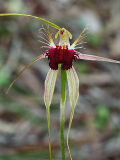
(Caladenia huegelii)

(Caladenia thinicola)
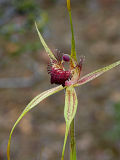
(Caladenia pectinata)

(Caladenia procera)
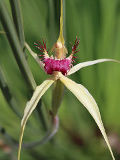
(Caladenia viridescens)

(Caladenia paludosa)

(Caladenia applanata)

(Caladenia williamsiae)

(Caladenia rhomboidiformis)

(Caladenia ensata)

(Caladenia longiclavata)

(Caladenia magniclavata)
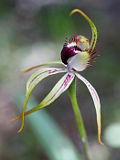
(Caladenia hoffmanii)

(Caladenia corynephora)
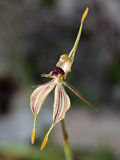
(Caladenia plicata)

(Caladenia infundibularis)

(Caladenia falcata)

(Caladenia attingens)

(Caladenia integra)
Subgenus Drakonorchis – Dragon Orchids
Subgenus Phlebochilus – Wispy Spider Orchids
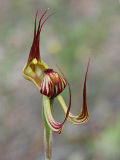
(Caladenia multiclavia)

(Caladenia roei)
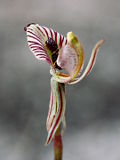
(Caladenia cairnsiana)

(Caladenia nobilis)
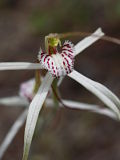
(Caladenia varians)

(Caladenia pendens)
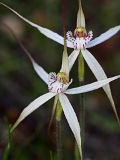
(Caladenia incensa)

(Caladenia bigeminata)
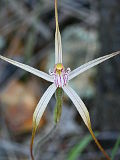
(Caladenia exilis)

(Caladenia fluvialis)
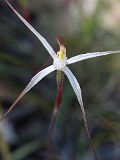
(Caladenia microchila)
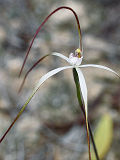
(Caladenia paradoxa)

(Caladenia sp.)

(Caladenia polychroma)
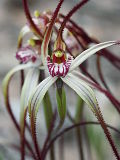
(Caladenia dimidia)

(Caladenia radialis)
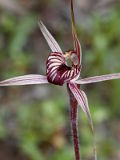
(Caladenia wanosa)

(Caladenia xantha)

(Caladenia denticulata)
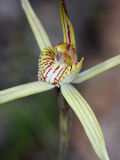
(Caladenia straminichila)
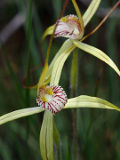
(Caladenia elegans)

(Caladenia sp.)

(Caladenia sp.)

(Caladenia caesarea)

(Caladenia chapmanii)

(Caladenia filifera)

(Caladenia pulchra)
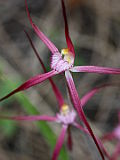
(Caladenia footeana)
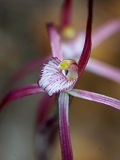
(Caladenia occidentalis)
Hybrids

Caladenia carnea × Caladenia catenata

(Caladenia × spectabilis)

Caladenia flava × Caladenia reptans

Caladenia longicauda × Caladenia pendens
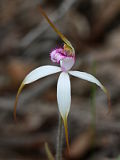
(Caladenia × suffusa)

(Caladenia × exserta)

(Caladenia × cala)
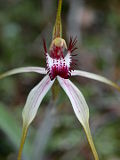
Caladenia hoffmanii × Caladenia longicauda
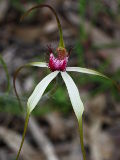
Caladenia longicauda × Caladenia lorea

Caladenia arenicola × Caladenia longicauda
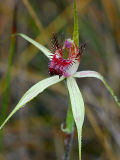
Caladenia arenicola × Caladenia swartsiorum

Caladenia arenicola × Caladenia georgei

Caladenia arenicola × Caladenia paludosa

Caladenia paludosa × Caladenia sp.
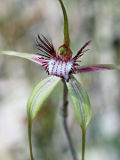
Caladenia swartsiorum × Caladenia sp.

Caladenia attingens × Caladenia infundibularis

Caladenia thinicola × Caladenia sp.
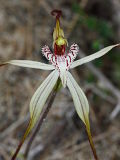
Caladenia varians × Caladenia sp.
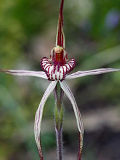
Caladenia cairnsiana × Caladenia polychroma

Caladenia incensa × Caladenia roei
Genus Caleana
This genus contains only a single species, the Large Duck Orchid, which is common and widespread across south-eastern Australia, including Tasmania. Its unusual flower resembles the shape of a duck in flight. Some authors have included the Duck Orchids (Paracaleana) in this genus.
Genus Calochilus – Beard Orchids
With their uniquely “bearded” labellum, Beard Orchids are among Australia’s most spectacular and easily recognisable orchids. Beard Orchids are mainly found across south-eastern Australia, where they are generally common and widespread. A few species can also be found in south-western WA and throughout the tropical parts of northern Australia, although they are generally less abundant in these areas. Beard Orchids are closely related to Sun Orchids (Thelymitra).
Genus Corybas – Helmet Orchids
Genus Cryptostylis
These weird-looking orchids can be found across southern Australia, with four out of five Australian species occurring in the south-east and just one, the Slipper Orchid, in the south-west. They are unusual in that they have green leaves all year round, while most other terrestrial orchids of Australia are dormant during the dry season.
Genus Cyanicula
This genus of mostly blue-flowered species is closely related to the Spider Orchids (Caladenia) and found across southern Australia. Many species are stimulated into flowering by fire, while others will flower freely without requiring a fire.
Genus Cyrtostylis
Genus Dendrobium
Genus Dipodium – Hyacinth Orchids
Genus Disa
This genus is rich in species and native to southern Africa, with one species, the South African Orchid, having been introduced to Western Australia by accident. First recorded at Albany in the 1940s, the South African Orchid has now spread across large parts of south-western and south-eastern Australia and is a common and widespread weed.
Genus Diuris – Donkey Orchids
Donkey Orchids are among Australia’s most common and widespread orchids. They are easily recognised by the two “donkey ears” formed by their two petals, although many species look very similar and are rather difficult to tell apart. Donkey Orchids are found throughout south-eastern and south-western Australia. They don’t produce any nectar, but instead imitate other native flowers to attract pollinators without offering any reward.

(Diuris brumalis)
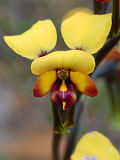
(Diuris perialla)

(Diuris corymbosa)

(Diuris porrifolia)

(Diuris brachyscapa)
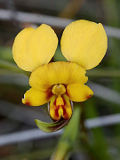
(Diuris oraria)
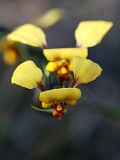
(Diuris refracta)

(Diuris recurva)

(Diuris tinkeri)

(Diuris magnifica)

(Diuris longifolia)

(Diuris jonesii)
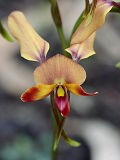
(Diuris ostrina)

(Diuris tinctoria)
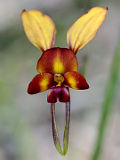
(Diuris cruenta)
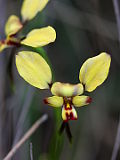
(Diuris sp.)

(Diuris sp.)

(Diuris sp.)

(Diuris sp.)

(Diuris laxiflora)

(Diuris decrementa)

(Diuris septentrionalis)
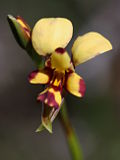
(Diuris segregata)

(Diuris sp. ‘Augusta’)
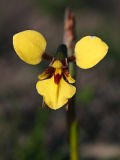
(Diuris laevis)
Genus Drakaea – Hammer Orchids
Hammer Orchids are among the most peculiar orchids of Australia and certainly among the least flower-like. They produce pheromones that attract male wasps. When the wasp gets hold of the labellum and attempts to fly off, the labellum flips over, pushing the wasp against the stigma and pollen. Hammer Orchids are entirely endemic to south-western Australia, and many species are rare and threatened.

(Drakaea glyptodon)

(Drakaea thynniphila)

(Drakaea gracilis)

(Drakaea livida)
Hybrids
Genus Elythranthera – Enamel Orchids
Being closely related to the Spider Orchids (Caladenia), this genus is endemic to south-western Australia and contains just two species, the Purple Enamel Orchid and the Pink Enamel Orchid. Both are generally common and widespread and easily identified by their glossy flowers.
Hybrids
Genus Ericksonella
Genus Eriochilus – Bunny Orchids
Genus Gastrodia
Genus Glossodia
Genus Leporella
This genus is closely related to the Spider Orchids (Caladenia) and contains just a single species, the rather unique Hare Orchid, which is found across south-western WA and parts of south-eastern SA and south-western VIC. While common, the Hare Orchid’s tiny flowers are perfectly camouflaged and easily overlooked amid the surrounding vegetation.
Genus Leptoceras
Genus Lyperanthus
Genus Microtis – Mignonette Orchids
Genus Orthoceras – Horned Orchids
Genus Paracaleana – Duck Orchids
Duck Orchids are among the most peculiar orchids of Australia. Their strange, duck-shaped flowers produce a pheromone that attracts male thynnid wasps. When the wasp lands on the labellum and attempts to mate with the flower, the labellum flips over and pushes the wasp against the stigma and pollen. Duck Orchids are found throughout southern Australia, including Tasmania, although most species are endemic to south-western Australia. Some authors have included this genus in the closely related genus Caleana.

(Paracaleana minor)

(Paracaleana lyonsii)

(Paracaleana nigrita)

(Paracaleana alcockii)

(Paracaleana hortiorum)
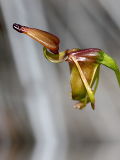
(Paracaleana terminalis)

(Paracaleana triens)

(Paracaleana brockmanii)

(Paracaleana ferricola)

(Paracaleana granitica)

(Paracaleana gracilicordata)
Genus Pheladenia
This genus contains just a single species, the Blue Fairy Orchid, which is found throughout southern Australia and closely related to the Spider Orchids (Caladenia).
Genus Praecoxanthus
This genus contains just a single species, the Leafless Orchid, which is endemic to south-western Australia and closely related to the Spider Orchids (Caladenia).
Genus Prasophyllum – Leek Orchids
Leek Orchids are among Australia’s tallest orchids, with some species growing up to 2 metres tall. They are generally found across south-eastern and south-western Australia, including Tasmania. Many Leek Orchids will only produce flowers in the season following a bushfire, while others will flower every year without requiring a fire.

(Prasophyllum fimbria)

(Prasophyllum brownii)

(Prasophyllum giganteum)
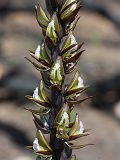
(Prasophyllum elatum)

(Prasophyllum hians)

(Prasophyllum drummondii)

(Prasophyllum gracile)

(Prasophyllum plumiforme)

(Prasophyllum ovale)

(Prasophyllum cyphochilum)
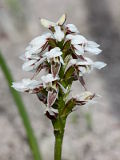
(Prasophyllum cucullatum)

(Prasophyllum parvifolium)

(Prasophyllum sp.)
Genus Pterostylis – Greenhood Orchids
Greenhood Orchids are among Australia’s most common and widespread orchids. They can be found almost anywhere from the semi-arid interior to the temperate rainforests in the south. With their generally greenish and brownish colours, most Greenhoods are rather inconspicuous and easily overlooked. Many of them look alike and can be difficult to identify in the wild. In addition, there is still a large number of undescribed or undiscovered species.
Subgenus Pterostylis
Section Pterostylis
Section Foliosae – Snail Orchids and Shell Orchids
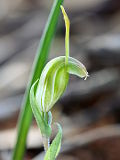
(Pterostylis platypetala)

(Pterostylis dilatata)

(Pterostylis pyramidalis)
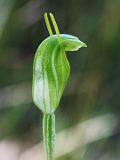
(Pterostylis brevisepala)

(Pterostylis glebosa)

(Pterostylis ectypha)
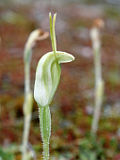
(Pterostylis setulosa)
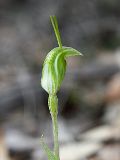
(Pterostylis crispula)
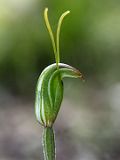
(Pterostylis erubescens)

(Pterostylis hamiltonii)

(Pterostylis aspera)

(Pterostylis grandiflora)
Subgenus Oligochaetochilus
Section Catochilus – Bird Orchids
Section Oligochaetochilus – Rufous Greenhoods
Section Stamnorchis – Jug Orchid
Section Urochilus – Banded Greenhoods

(Pterostylis vittata)

(Pterostylis sanguinea)

(Pterostylis orbiculata)

(Pterostylis concava)

(Pterostylis atrosanguinea)

(Pterostylis sp. ‘northern’)

(Pterostylis sp.)

(Pterostylis sargentii)
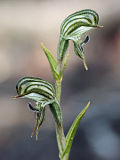
(Pterostylis occulta)
Section Squamatae
Genus Pyrorchis
Genus Spiculaea
This genus contains just a single species, the bizarre-looking Elbow Orchid, which is endemic to south-western Australia where it is generally common and widespread.
Genus Thelymitra – Sun Orchids
Sun Orchids are found across southern Australia, including Tasmania, and are easily recognised by their characteristic flowers which lack a special labellum. Instead, all sepals and petals are of roughly the same colour and size. Their common name refers to the fact that many species will only open their flowers on warm and sunny days. Sun Orchids don’t produce nectar, but instead imitate other flowers to fool insects who will pollinate the orchids without getting any reward. While the Sun Orchids of south-eastern Australia are mostly uniformly blue, the species of south-western Australia come in a wide range of spectacular colours and contain some of Australia’s most beautiful orchids.

(Thelymitra ixioides)

(Thelymitra crinita)

(Thelymitra macrophylla)

(Thelymitra graminea)

(Thelymitra petrophila)

(Thelymitra sp. ‘Murchison’)

(Thelymitra vulgaris)

(Thelymitra latiloba)

(Thelymitra apiculata)

(Thelymitra variegata)

(Thelymitra pulcherrima)
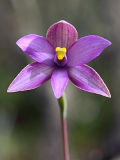
(Thelymitra spiralis)

(Thelymitra flexuosa)

(Thelymitra antennifera)

(Thelymitra villosa)

(Thelymitra sargentii)
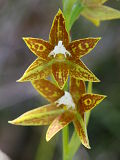
(Thelymitra fuscolutea)

(Thelymitra benthamiana)
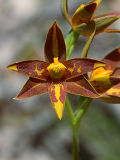
(Thelymitra stellata)
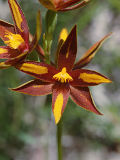
(Thelymitra magnifica)





